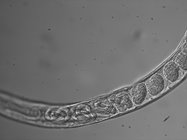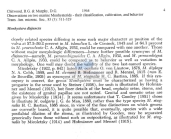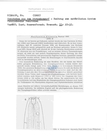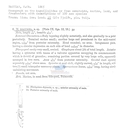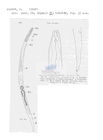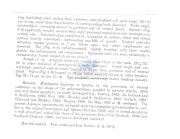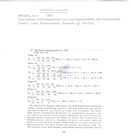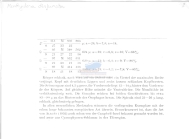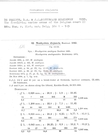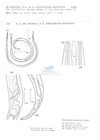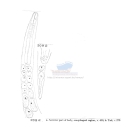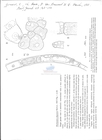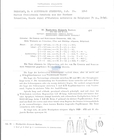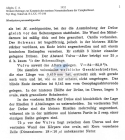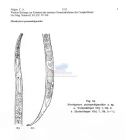
|
World Database of NematodesLinked to the Marine Biology Section, UGent |
| Start | Browse taxonomy |
Search taxonomy |
Search literature |
Search distributions |
Identification keys |
Media gallery | Editors | Statistics | Citations | Match taxa | Contact | Login |
RAS taxon detailsHalomonhystera disjuncta (Bastian, 1865) Andrássy, 2006
468111 (urn:lsid:marinespecies.org:taxname:468111)
accepted
Species
Monhystera disjuncta Bastian, 1865 · unaccepted
Monhystera paraambiguoides Allgén, 1932 · unaccepted
Monhystera praevulvata Allgén, 1932 · unaccepted
marine
(of Monhystera disjuncta Bastian, 1865) Bastian, H. C. (1865). Monograph of the Anguillulidae, or Free Nematoids, Marine, Land, and Freshwater; with Descriptions of 100 New Species. The Transactions of the Linnean Society of London. Volume XXV. Part II:73-184. [details]
Nemys eds. (2024). Nemys: World Database of Nematodes. Halomonhystera disjuncta (Bastian, 1865) Andrássy, 2006. Accessed through: RAS (Eds.) (2024) Register of Antarctic Species at: https://ras.biodiversity.aq/aphia.php?p=taxdetails&id=468111 on 2025-04-04
RAS (Eds.) (2025). Register of Antarctic Species. Halomonhystera disjuncta (Bastian, 1865) Andrássy, 2006. Accessed at: https://ras.biodiversity.aq/aphia.php/aphia.php?p=taxdetails&id=468111 on 2025-04-04
Date action by
original description
(of Monhystera disjuncta Bastian, 1865) Bastian, H. C. (1865). Monograph of the Anguillulidae, or Free Nematoids, Marine, Land, and Freshwater; with Descriptions of 100 New Species. The Transactions of the Linnean Society of London. Volume XXV. Part II:73-184. [details]
original description (of Monhystera paraambiguoides Allgén, 1932) Allgén, C. A. (1932). Weitere Beiträge zur Kenntnis der marinen Nematodenfauna der Campbellinsel. Nyt Mag. Naturvid. 70: 97-198. [details] Available for editors original description (of Monhystera praevulvata Allgén, 1932) Allgén, C. A. (1932). Weitere Beiträge zur Kenntnis der marinen Nematodenfauna der Campbellinsel. Nyt Mag. Naturvid. 70: 97-198. [details] Available for editors taxonomy source Derycke, S.; Backeljau, T.; Vlaeminck, C.; Vierstraete, A.; Vanfleteren, J.; Vincx, M.; Moens, T. (2007). Spatiotemporal analysis of population genetic structure in Geomonhystera disjuncta (Nematoda, Monhysteridae) reveals high levels of molecular diversity. Marine Biology. 151(5): 1799-1812. (look up in IMIS), available online at https://doi.org/10.1007/s00227-007-0609-0 [details] Available for editors taxonomy source Derycke, S.; Van Vynckt, R.; Vanaverbeke, J.; Vincx, M.; Moens, T. (2007). Colonization patterns of Nematoda on decomposing algae in the estuarine environment: community assembly and genetic structure of the dominant species Pellioditis marina. Limnology and Oceanography. 52(3): 992-1001. (look up in IMIS) [details] Available for editors context source (Deepsea) Miljutin, D. M.; Gad, G.; Miljutina, M. M.; Mokievsky, V. O.; Fonseca-Genevois, V.; Esteves, A. M. (2010). The state of knowledge on deep-sea nematode taxonomy: how many valid species are known down there?. Marine Biodiversity. 40(3): 143-159., available online at https://doi.org/10.1007/s12526-010-0041-4 [details] Available for editors additional source Vanreusel, A.; Andersen, A.C.; Boetius, A.; Connelly, D.; Cunha, M.R.; Decker, C.; Hilario, A.; Kormas, K.A.; Maignien, L.; Olu, K.; Pachiadaki, M.; Ritt, B.; Rodrigues, C.; Sarrazin, J.; Tyler, P.; Van Gaever, S.; Vanneste, H. (2009). Biodiversity of cold seep ecosystems along the continental margin. Oceanography. 22 (1): 109-127. [details] Available for editors additional source Van Campenhout, J.; Vanreusel, A.; Van Belleghem, S.; Derycke, S. (2015). Transcription, Signaling Receptor Activity, Oxidative Phosphorylation, and Fatty Acid Metabolism Mediate the Presence of Closely Related Species in Distinct Intertidal and Cold-Seep Habitats. Genome Biology and Evolution. 8(1): 51-69., available online at https://doi.org/10.1093/gbe/evv242 [details] Available for editors additional source Tchesunov, A. V.; Portnova, D. A.; Van Campenhout, J. (2015). Description of two free-living nematode species of Halomonhystera disjuncta complex (Nematoda: Monhysterida) from two peculiar habitats in the sea. Helgoland Marine Research. 69(1): 57-85., available online at https://doi.org/10.1007/s10152-014-0416-1 [details] additional source Fonseca, G.; Derycke, S.; Moens, T. (2008). Integrative taxonomy in two free-living nematode species complexes. Biological Journal of the Linnean Society. 94(4): 737-753. (look up in IMIS), available online at https://doi.org/10.1111/j.1095-8312.2008.01015.x [details] additional source Van Gaever, S.; Galéron, J.; Sibuet, M.; Vanreusel, A. (2009). Deep-sea habitat heterogeneity influence on meiofaunal communities in the Gulf of Guinea. Deep Sea Research Part II: Topical Studies in Oceanography. 56(23): 2259-2269., available online at https://doi.org/10.1016/j.dsr2.2009.04.008 [details] Available for editors additional source Van Gaever, S.; Moodley, L.; De Beer, D.; Vanreusel, A. (2006). Meiobenthos at the Arctic Håkon Mosby Mud Volcano, with a parental-caring nematode thriving in sulphide-rich sediments. Marine Ecology Progress Series. 321: 143-155., available online at https://doi.org/10.3354/meps321143 [details] Available for editors additional source Van Gaever, S.; Olu, K.; Derycke, S.; Vanreusel, A. (2009). Metazoan meiofaunal communities at cold seeps along the Norwegian margin: Influence of habitat heterogeneity and evidence for connection with shallow-water habitats. Deep Sea Research Part I: Oceanographic Research Papers. 56(5): 772-785., available online at https://doi.org/10.1016/j.dsr.2008.12.015 [details] Available for editors additional source Van Gaever, S.; Raes, M.; Pasotti, F.; Vanreusel, A. (2009). Spatial scale and habitat-dependent diversity patterns in nematode communities in three seepage related sites along the Norwegian Sea margin. Marine Ecology. 31(1): 66-77., available online at https://doi.org/10.1111/j.1439-0485.2009.00314.x [details] Available for editors additional source Kito, K. (1981). Studies on the free-living marine nematodes from Hokkaido, IV. Jour. Fac. Sci. Hokkaido Univ. Ser. VI, Zool. 22 (3): 250-278. [details] Available for editors additional source Yeates, G. W. (2010). Phylum Nematoda: roundworms, eelworms. in: Gordon, D.P. (Ed.) (2010). New Zealand inventory of biodiversity: 2. Kingdom Animalia: Chaetognatha, Ecdysozoa, Ichnofossils. pp. 480-493. [details] additional source Leduc, D.; Gwyther, J. (2008). Description of new species of Setosabatieria and Desmolaimus (Nematoda: Monhysterida) and a checklist of New Zealand free-living marine nematode species. New Zealand Journal of Marine and Freshwater Research. 42(3): 339-362., available online at https://doi.org/10.1080/00288330809509962 [details] Available for editors new combination reference Andrássy, I. (2006). Halomonhystera, a new genus distinct from Geomonhystera Andrássy, 1981 (Nematoda: Monhysteridae). Meiofauna Marina. 15, 11-24, 2 figs. [details] Available for editors toxicology source Mevenkamp, L., Brown A., Hauton C., Kordas, A., Thatje, S., Vanreusel, A. (2017). Hydrostatic pressure and temperature affect the tolerance of the free-living marine nematode Halomonhystera disjuncta to acute copper exposure. Aquatic toxicology. 192: 178-183. [details] Available for editors ecology source Derycke, S.; Vanaverbeke, J.; Rigaux, A.; Backeljau, T.; Moens, T. (2010). Exploring the Use of Cytochrome Oxidase c Subunit 1 (COI) for DNA Barcoding of Free-Living Marine Nematodes. PLoS ONE. 5(10): e13716., available online at https://doi.org/10.1371/journal.pone.0013716 [details] Available for editors ecology source Grzelak, K.; Kotwicki, L. (2014). Halomonhystera disjuncta- a young-carrying nematode first observed for the Baltic sea in deep basins within chemical munitions disposal sites. Deep Sea Research Part II: Topical Studies in Oceanography. , available online at https://doi.org/10.1016/j.dsr2.2014.12.007 [details] Available for editors ecology source Mevenkamp, L., J. Van Campenhout & A. Vanreusel. (2016). Experimental evidence for selective settlement of meiofauna from two distinct environments after sediment suspension. Journal Of Experimental Marine Biology And Ecology. 474:195-203., available online at https://doi.org/10.1016/j.jembe.2015.10.005 [details]  Present Present  Inaccurate Inaccurate  Introduced: alien Introduced: alien  Containing type locality Containing type locality
Original description (NemasLan)
Original description (NemasLan) Original description (NemasLan) Original description (NemasLan) Original description (NemasLan) Original description (NemasLan) Original description (NemasLan) To Barcode of Life (1 barcode) To Biodiversity Heritage Library (8 publications) (from synonym Monhystera disjuncta Bastian, 1865) To European Nucleotide Archive, ENA (Halomonhystera disjuncta) To GenBank (390 nucleotides; 45 proteins) To PESI (from synonym Monhystera disjuncta Bastian, 1865) To PESI To PESI (from synonym Monhystera paraambiguoides Allgén, 1932) To USNM Invertebrate Zoology Nematoda Collection (17 records) (from synonym Monhystera disjuncta Bastian, 1865) From editor or global species database
Image from synonym
Image from synonym
Image from synonym
Image from synonym
Image from synonym
Image from synonym
Image from synonym
Image from synonym
Image from synonym
Image from synonym
Image from synonym
Image from synonym
Image from synonym
Image from synonym
Image from synonym
Image from synonym
Image from synonym
Image from synonym
Image from synonym
Image from synonym
Image from synonym
Image from synonym
Image from synonym
Image from synonym
Image from synonym
Image from synonym
Image from synonym
Image from synonym
Image from synonym
Image from synonym
|
Web interface and database structure initially created by Tim Deprez; now hosted and maintained by VLIZ
Page generated 2025-04-05 · contact: Tânia Nara Bezerra or info@marinespecies.org
